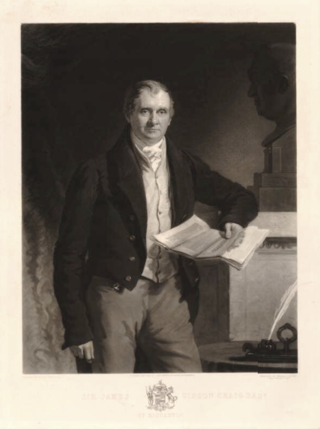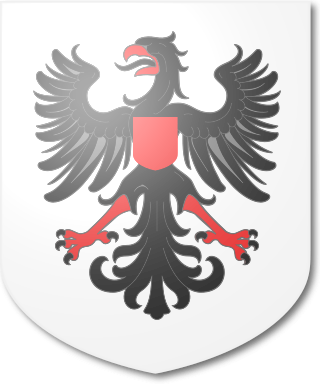
Viscount Hardinge, of Lahore and of Kings Newton in the County of Derby, is a title in the Peerage of the United Kingdom. It was created in 1846 for the soldier and Tory politician Sir Henry Hardinge. His son, the second Viscount, represented Downpatrick in Parliament. His great-great-grandson, the sixth Viscount, succeeded a distant relative as eighth Baronet, of Belle Isle in the County of Fermanagh, in 1986. This title had been created in the Baronetage of the United Kingdom 1801 for Richard Hardinge. He was the third son of Nicolas Hardinge, younger brother of Reverend Henry Hardinge and uncle of the latter's third son Henry Hardinge, 1st Viscount Hardinge. The baronetcy was created with special remainder to the heirs male of Richard Hardinge's father.

The Cumming-Gordon, later Gordon-Cumming Baronetcy, of Altyre near Forres, is a title in the Baronetage of the United Kingdom. It was created on 27 May 1804 for Alexander Cumming-Gordon, formerly member of parliament for Inverness Burghs. The Cumyn or Cumming family had been settled in Scotland since the 12th century. One member of the family, John II Comyn, Lord of Badenoch, married Eleanor, sister of King John of Scotland. Their son John III Comyn, Lord of Badenoch, known as the "Red Comyn", was a claimant to the Scottish throne through his mother. A later member of the family, Robert Cumming, 13th of Altyre, married Lucy, daughter of Sir Ludovic Gordon of Gordonstoun. Their great-grandson was the first Baronet, who assumed the additional surname of Gordon on succeeding to the Gordon of Gordonstoun estates. The second Baronet sat as Member of Parliament for Elgin Burghs. He changed the family surname from Cumming-Gordon to Gordon-Cumming. The fourth Baronet is best known as a central figure in the Royal Baccarat Scandal.

The Eliott Baronetcy, of Stobs in the County of Roxburgh, is a title in the Baronetage of Nova Scotia. It was created on 3 December 1666 for Gilbert Eliott. The second baronet was a member of the pre-union Parliament of Scotland. The third Baronet sat as Member of Parliament for Roxburghshire. The Eliott Baronets share a common early Elliot ancestry with the nearby Earls of Minto (Elliot). It is thought that the surname spelling differences were contrived to differentiate the branches.

The Gibson, later Gibson-Carmichael, later Gibson-Craig-Carmichael Baronetcy, of Keirhill in the County of Edinburgh, is a title in the Baronetage of Nova Scotia. It was created on 31 December 1702 for Thomas Gibson, with remainder to his heirs male. The sixth Baronet assumed the additional surname of Carmichael. The eleventh Baronet was a Liberal politician. In 1912, he created Baron Carmichael, of Skirling in the County of Peebles, in the Peerage of the United Kingdom. The barony died in 1926, while he was succeeded in the baronetcy by his kinsman Sir Henry Thomas Gibson-Craig-Carmichael, 5th Baronet, of Riccarton, who became the twelfth Baronet of Keirhill and assumed the additional surname of Carmichael.

The Gibson-Craig, later Gibson-Craig-Carmichael baronetcy, of Riccarton in the County of Midlothian, was created in the Baronetage of the United Kingdom on 30 September 1831 for James Gibson-Craig, of 7 North St Andrew Square, Edinburgh, a Scottish lawyer and government official, formerly a supporter of Charles James Fox. Born James Gibson, he assumed the additional surname of Craig in 1818.
There have been four baronetcies created for persons with the surname Bell, all in the Baronetage of the United Kingdom. One creation is extant as of 2007.

The Baynes Baronetcy, of Harefield Place in the County of Middlesex, is a title in the Baronetage of the United Kingdom. It was created on 29 June 1801 for Christopher Baynes. He was Major-Commandant of the Uxbridge Gentlemen and Yeomanry Cavalry, which he helped to raise. The title descended from father to son until the death of his great-great-grandson, the fifth Baronet, in 1971. The late Baronet died unmarried and was succeeded by his first cousin, the sixth Baronet. He was the son of Reverend Malcolm Charles Baynes, fourth son of the third Baronet. As of 2023 the title is held by his grandson, the eighth Baronet, who succeeded his father in 2005.

The Muir Mackenzie Baronetcy, of Delvine in the County of Perth, is a title in the Baronetage of the United Kingdom. It was created on 9 November 1805 for Alexander Muir Mackenzie. Born Alexander Muir, he had assumed the additional surname of Mackenzie on succeeding to the estates of his great-uncle John Mackenzie, of Delvine, Perthshire, third son of Sir Kenneth Mackenzie, 1st Baronet, of Coul.

The Wedderburn, later Ogilvy-Wedderburn Baronetcy, of Balindean in the County of Perth, is a title in the Baronetage of the United Kingdom created in 1803.
There have been two baronetcies created for persons with the surname Gibbons, one in the Baronetage of Great Britain and one in the Baronetage of the United Kingdom. One creation is extant as of 2012.

Sir Alexander Charles Ramsay-Gibson-Maitland, 3rd baronet was a Scottish Liberal politician who sat in the House of Commons from 1868 to 1874.
Sir Alexander Maitland, 1st Baronet was a general in the British Army and the first of the Maitland baronets of Clifton. He was the fifth son of Charles Maitland, 6th Earl of Lauderdale.

The Robinson Baronetcy, of Toronto in Canada, was created in the Baronetage of the United Kingdom on 21 September 1854 for the Canadian lawyer and politician John Robinson.

Sir James Gibson-Craig, 1st Baronet (1765–1850) was a Scottish lawyer and government official. In politics he was a Foxite Whig. In early life he was known as James Gibson of Ingleston. He was created a baronet in the Baronetage of the United Kingdom in 1831.

The Ramsay baronetcy, of Bamff in the County of Perth, was created in the Baronetage of Nova Scotia on 3 December 1666 for Gilbert Ramsay. The title became extinct on the death of the twelfth Baronet in 1986.
The Ramsay baronetcy, of Balmain in the County of Kincardine, was created in the Baronetage of the United Kingdom on 13 May 1806 for Alexander Ramsay.

The Campbell baronetcy, of Barcaldine in the County of Argyll and of Glenure, was created in the Baronetage of the United Kingdom on 30 September 1831 for the soldier Duncan Campbell.

The Mackenzie baronetcy, of Coul (Coull) in the County of Ross, was created in the Baronetage of Nova Scotia on 16 October 1673 for Kenneth Mackenzie. His father Alexander Mackenzie of Coul was the illegitimate son of Colin Cam Mackenzie, 11th of Kintail, and half-brother of Kenneth Mackenzie, 1st Lord Mackenzie of Kintail, ancestor of the Earls of Seaforth, and of Sir Roderick Mackenzie, ancestor of the Earls of Cromarty. The 3rd Baronet was involved in the Jacobite rising of 1715. He was attainted with the baronetcy forfeited.

The Jackson baronetcy, of Arlsey in the County of Bedford, was created in the Baronetage of the United Kingdom on 22 May 1815 for John Jackson. He was a Director of the Honourable East India Company and also represented Dover in the House of Commons.
The Forbes-Leith of Fyvie baronetcy, of Jessfield in the County of Midlothian, originally the Burn baronetcy, was created in the Baronetage of the United Kingdom on 7 March 1923 for the soldier and Conservative politician Charles Rosdew Burn. He had previously represented Torquay in the House of Commons. Burn was the youngest son of General Robert Burn and the husband of Hon. Ethel, only daughter and heiress of Alexander John Forbes-Leith, 1st Baron Leith of Fyvie.
















